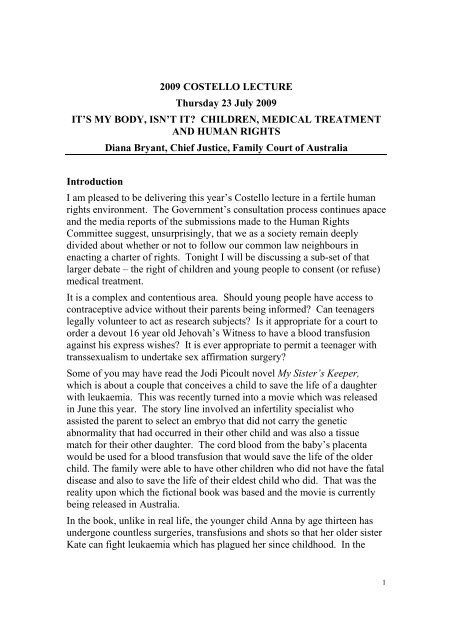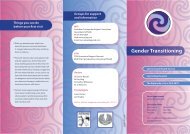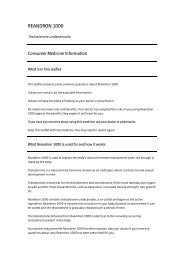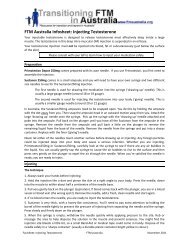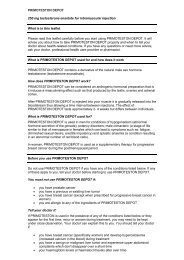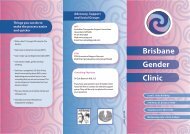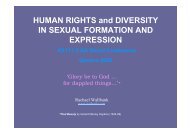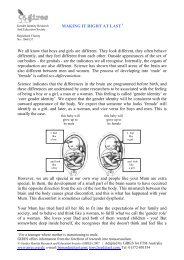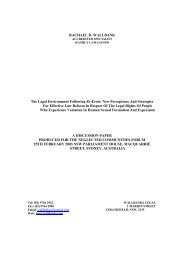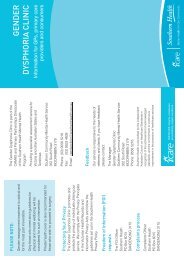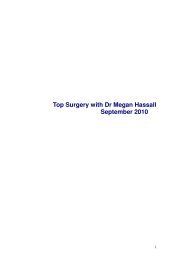It's My Body Isn't It - FTM Australia
It's My Body Isn't It - FTM Australia
It's My Body Isn't It - FTM Australia
You also want an ePaper? Increase the reach of your titles
YUMPU automatically turns print PDFs into web optimized ePapers that Google loves.
2009 COSTELLO LECTURE<br />
Thursday 23 July 2009<br />
IT’S MY BODY, ISN’T IT? CHILDREN, MEDICAL TREATMENT<br />
AND HUMAN RIGHTS<br />
Introduction<br />
Diana Bryant, Chief Justice, Family Court of <strong>Australia</strong><br />
I am pleased to be delivering this year’s Costello lecture in a fertile human<br />
rights environment. The Government’s consultation process continues apace<br />
and the media reports of the submissions made to the Human Rights<br />
Committee suggest, unsurprisingly, that we as a society remain deeply<br />
divided about whether or not to follow our common law neighbours in<br />
enacting a charter of rights. Tonight I will be discussing a sub-set of that<br />
larger debate – the right of children and young people to consent (or refuse)<br />
medical treatment.<br />
<strong>It</strong> is a complex and contentious area. Should young people have access to<br />
contraceptive advice without their parents being informed? Can teenagers<br />
legally volunteer to act as research subjects? Is it appropriate for a court to<br />
order a devout 16 year old Jehovah’s Witness to have a blood transfusion<br />
against his express wishes? <strong>It</strong> is ever appropriate to permit a teenager with<br />
transsexualism to undertake sex affirmation surgery?<br />
Some of you may have read the Jodi Picoult novel <strong>My</strong> Sister’s Keeper,<br />
which is about a couple that conceives a child to save the life of a daughter<br />
with leukaemia. This was recently turned into a movie which was released<br />
in June this year. The story line involved an infertility specialist who<br />
assisted the parent to select an embryo that did not carry the genetic<br />
abnormality that had occurred in their other child and was also a tissue<br />
match for their other daughter. The cord blood from the baby’s placenta<br />
would be used for a blood transfusion that would save the life of the older<br />
child. The family were able to have other children who did not have the fatal<br />
disease and also to save the life of their eldest child who did. That was the<br />
reality upon which the fictional book was based and the movie is currently<br />
being released in <strong>Australia</strong>.<br />
In the book, unlike in real life, the younger child Anna by age thirteen has<br />
undergone countless surgeries, transfusions and shots so that her older sister<br />
Kate can fight leukaemia which has plagued her since childhood. In the<br />
1
ook and movie Anna was conceived as a bone marrow match for Kate, a<br />
life role that she had never questioned until she became a teenager and<br />
started to have doubts. The book and film raise issues such as: is it morally<br />
correct to do whatever it takes to save a child’s life – even if that means<br />
infringing on the rights of another? When Kate’s kidneys fail Anna is<br />
expected to donate one of her own but hires a lawyer to be medically<br />
emancipated from her parents and to gain the right to make the decision<br />
herself. There is more to the film and those who have not read the book or<br />
even those who have it looks as if it will be an interesting and thought<br />
provoking film and clearly it is not far fetched. <strong>It</strong> is based at least on the<br />
true story that I commenced with and it is not that different from a case<br />
which found its way to the Family Court in 2007. 1<br />
That case concerned a baby who was 8 months old and who suffered from<br />
Infantile Osteopetrosis. Without a bone marrow transplant he was likely to<br />
die and the bone marrow transplant was his only potential cure. His cousin<br />
was just a little older than him, being one year old. The mother of the baby<br />
is the sister of the father of the one year old and two children were therefore<br />
cousins. Their parents were not only siblings but were very close by virtue<br />
of family ties and culture. The parents of the baby asked the court to make<br />
an order authorising the taking of bone marrow from the one year old so that<br />
it could specifically be transplanted into her cousin and potentially save his<br />
life.<br />
In Victoria this kind of procedure is governed by the Human Tissue Act 1982<br />
(Vic) which provides prohibition against the removal of tissue from children<br />
except in certain circumstances, ‘tissue’ being defined to include an organ or<br />
part of a body. There is an exception for a class of children. A parent may<br />
give consent for the removal from the body of a child of specified<br />
regenerative tissue for the purpose of transplantation to the body of a<br />
brother, sister or parent of the child. In addition the medical practitioner who<br />
has to certify in these circumstances must be satisfied that the brother or<br />
sister is likely to die unless the tissue is transplanted.<br />
Despite the prohibition in the state legislation, because this was an<br />
application made to the Family Court under the Family Law Act 1975 (Cth),<br />
it was open to the trial judge to find that the Family Law Act overrode the<br />
state legislation.<br />
Various questions arose for determination including the following:<br />
1 Re: Inaya (Special Medical Procedure) [2007] FamCA 658.<br />
2
The Victorian Act would authorise the removal of tissue from the one year<br />
old but only in respect of her own treatment. Could it be argued that the use<br />
of the words “in the interest and health of the person” might include the<br />
future psychological health of the one year old child? That is, that if she<br />
were later to learn that she could have assisted in the recovery of her cousin<br />
but did not do so, would that have adverse affects on her?<br />
All concerned, that is both families and the independent children’s lawyer,<br />
supported the making of the orders. The procedure itself carried some risks<br />
for the one year old. This was not the first such case to be determined by the<br />
Family Court. Similar cases had been determined in as early as 1997<br />
involving an application for a bone marrow transplant between a willing and<br />
knowledgeable child and an adult aunt, and another in 1999.<br />
The judge found there was inconsistency between the state and federal<br />
legislation and therefore the federal legislation – the Family Law Act –<br />
applied. 2 There was psychological evidence about the family and its culture<br />
and the relationship between the two children and their families who were<br />
living together. The psychologist ultimately opined that the one year old<br />
might suffer psychological harm derived from guilt, self blame and exposure<br />
to a traumatised and grief-stricken family and community if the procedure<br />
was not performed. The trial judge found that it was in the best interests of<br />
the one year old to make the order for bone marrow harvesting.<br />
I do not intend today to go into the issues about how the jurisdiction can be<br />
exercised, or to further explore all the kinds of cases that will conceivably<br />
arise in the foreseeable, but these cases underline what I want to take about<br />
today which is the rights of the child as opposed to the child’s best<br />
interests.<br />
One of the responsibilities of being a judge is to decide such cases. I have<br />
done so myself, in the case of Re: Alex(2), which involved an application to<br />
permit a double mastectomy to be performed on a teenager who was<br />
biologically female but whose affirmed sex was male.<br />
Litigation in this area is characterised by ‘conflict of rights’ arguments: the<br />
right to bodily integrity and self determination versus parents’ right to ensure<br />
that children are protected from harm and from making impetuous decisions<br />
inimicable to their best interests. This conflict is particularly acute where<br />
teenagers are involved, who with increasing maturity and insight are<br />
arguably able to make their own decisions about medical treatment.<br />
2 Section 109 of the <strong>Australia</strong>n Constitution provides that a law of the Commonwealth overrides a law of a<br />
State to the extent of any inconsistency.<br />
3
The resolution of this conflict occurs without the assistance of a statutory<br />
human rights framework. This is in contrast to virtually all other common<br />
law countries. Later in my presentation I will be comparing the position in<br />
<strong>Australia</strong> as pertaining to young people and medical treatment with that of<br />
the United Kingdom, which has had a Human Rights Act in force for ten<br />
years. <strong>My</strong> contention is that legislating to protect human rights in <strong>Australia</strong><br />
would see young people’s right to autonomy, privacy and self-determination<br />
emerge with far greater clarity in this very difficult area of the law.<br />
International human rights in <strong>Australia</strong>n law<br />
Although <strong>Australia</strong> does not have a Bill of Rights and the <strong>Australia</strong>n<br />
Constitution contains few express rights, that does not mean that human<br />
rights principles are alien to our municipal law. 3 We have ratified the<br />
International Covenant on Civil and Political Rights and the International<br />
Covenant on Economic, Social and Cultural Rights.<br />
Successive <strong>Australia</strong>n governments enacted specific legislation to give effect<br />
to its international obligations in the areas of racial discrimination, sex<br />
discrimination, disability discrimination and age discrimination. 4 The<br />
Human Rights and Equal Opportunity Commission (HREOC) administers<br />
these four Acts, as well as the Human Rights and Equal Opportunity Act<br />
1986 (Cth).<br />
A particularly important human rights instrument affecting children is the<br />
United Nations Convention on the Rights of the Child (UNCROC), the most<br />
ratified of all the international human rights treaties. The <strong>Australia</strong>n<br />
Government ratified UNCROC on 17 December 1990 and entered into force<br />
on 16 January 1991. To date however, no Government has passed<br />
legislation that seeks to give domestic effect to the rights of the child as<br />
embodied in the Convention.<br />
However, as the High Court confirmed in the decision Minister for<br />
Immigration and Ethnic Affairs v Teoh, the fact that UNCROC has not been<br />
incorporated into <strong>Australia</strong>n law does not mean that its ratification is of no<br />
significance. In their joint judgment, the (then) Chief Justice Mason and<br />
Justice Deane said: “Where a statute or subordinate legislation is<br />
3 Those rights include s 40, the right to vote, s 116, the right to freedom of religion, and s 117, the right to<br />
freedom from disabilities or discrimination on the basis of State residence. There is however a large body of<br />
jurisprudence on implied rights and freedoms in the <strong>Australia</strong>n Constitution, including <strong>Australia</strong>n Capital<br />
Television Pty Ltd v Commonwealth (1992) 177 CLR 106 on the implied right of political freedom and Chu<br />
Kheng Lim v Minister for Immigration, Local Government and Ethnic Affairs (1992) 176 CLR 1 on the right to<br />
due process under the law.<br />
4 Racial Discrimination Act 1975 (Cth), Sex Discrimination Act 1984 (Cth), Disability Discrimination Act 1992<br />
(Cth), Age Discrimination Act 2004 (Cth).<br />
4
ambiguous, the courts should favour that construction which accords with<br />
<strong>Australia</strong>’s obligations under a treaty or international convention to which<br />
<strong>Australia</strong> is a party, at least in those cases in which the legislation is enacted<br />
after, or in contemplation of, entry into, or ratification of, the relevant<br />
international instrument. That is because Parliament, prima facie, intends to<br />
give effect to <strong>Australia</strong>’s obligations under international law.” 5<br />
The Full Court of the Family Court also considered the interaction between<br />
international human rights instruments, domestic law and the Family Court’s<br />
jurisdiction in the case of B & B: : Family Law Reform Act 1995. 6 HREOC<br />
and the Commonwealth Attorney-General were intervenors in the<br />
proceedings. At trial, an issue that assumed considerable significance was<br />
whether amendments to the Family Law Act made in 1995 were made in<br />
consideration or reliance upon UNCROC and the role of UNCROC in<br />
construing domestic law, in particular the Family Law Act. The Full Court<br />
opined that UNCROC is a Convention which has “received almost universal<br />
significance” 7 and, as such, one which must be given “special significance”<br />
for the purpose of interpreting domestic law. The fact that the Convention is<br />
expressed as a schedule to the HREOC Act was perceived by the Full Court<br />
to imbue it with even more significance in <strong>Australia</strong>n law.<br />
So, therefore, although UNCROC does not of itself create legally<br />
enforceable rights exercisable by <strong>Australia</strong>n children and young people, it is<br />
nevertheless a source of fundamental rights and freedoms in municipal law.<br />
The ascertainment of children’s rights arising at common law or under<br />
statute should therefore be undertaken by reference to the UNCROC.<br />
To my mind, those articles of UNCROC of particular relevance to ‘special<br />
medical procedure’ applications include:<br />
Article 12: The right of children to express views and have those views<br />
respected<br />
Article 13: The right to freedom of expression<br />
Article 16: the right to privacy<br />
Article 8: The right to preservation of identity<br />
Article 6: The right of survival and development<br />
Article 3 of UNCROC states that the best interests of a child should be a<br />
primary consideration. That understanding is embodied in the Family Law<br />
5 (1995) 183 CLR 273, 286-7.<br />
6 B and B: Family Law Reform Act 1995 (1997) FLC 92-755<br />
7 Ibid p. 84,227.<br />
5
Act. Section 60CA states that a child’s best interests are the paramount<br />
consideration in deciding whether to make a particular parenting order in<br />
respect of a child. Decisions about children’s medical treatment and<br />
particular whether the Court should authorise the performance of a special<br />
medical procedure on a child is a species of parenting order.<br />
The Family Court and special medical procedure applications<br />
But, you may ask, why is this so? Why does the Family Court needs to be<br />
involved at all? Surely making decisions about a child’s medical treatment<br />
is one of the responsibilities of parenthood and it should be up to parents and<br />
guardians to give their consent to medical treatment, including surgical<br />
intervention?<br />
As far as it goes, that is true. The Family Law Act presumptively vests<br />
parental responsibility in each parent, or parental responsibility can be<br />
allocated by court order. The exercise of that responsibility undoubtedly<br />
includes making decisions about children’s medical treatment.<br />
However, there are some procedures that by their very nature parents are<br />
deemed legally incapable of providing consent for and the permission of a<br />
Court is required, whether that be the Family Court of <strong>Australia</strong> or a State or<br />
Territory Supreme Court. Jurisdictionally, this is an exercise of what is<br />
known as courts’ parens patrie, or welfare, power. The power, found in<br />
common law and in statute, enables the Court to make any order that it<br />
considers proper for the care, welfare and protection of a child, within<br />
Constitutional limits.<br />
The term ‘special medical procedure’ doesn’t have a fixed meaning. We<br />
know however from the High Court’s decision in Re: Marion, 8 which<br />
concerned an application to sterilise a young woman with an intellectual<br />
disability, that medical treatment becomes a ‘special medical procedure’<br />
where it is for non-therapeutic purposes. The invasiveness of the procedure,<br />
its attendant risks to the child and whether or not is reversible are also<br />
relevant considerations. The Family Court developed an introductory guide<br />
to special medical procedure applications in 1998 which refers to<br />
sterilisation and “medical treatments which may not in themselves be grave<br />
and irreversible but may be of significant risk, ethically sensitive or<br />
disputed.” 9<br />
8<br />
Secretary, Department of Health and Community Services v. J.W.B. and S.M.B. (Marion's Case) (1992)<br />
175 CLR 218.<br />
9<br />
Family Court of <strong>Australia</strong>, A Question of Right Treatment: The Family Court and Special Procedures for<br />
Children, An introductory guide for use in Victoria, 1998.<br />
6
Ultimately, the decision whether or not to authorise a particular procedure is<br />
dependent upon whether so doing would be in the best interests of the child.<br />
The Family Law Act directs the Court to consider particular matters in<br />
considering whether or not to authorise that a special medical procedure be<br />
performed. 10 Importantly, these include any views expressed by the child<br />
and any factors (such as the child’s age and maturity) that are relevant to the<br />
weight the court should give to the child’s views. 11<br />
Nevertheless, as the former Chief Justice Nicholson observed, the ‘best<br />
interests’ test is by its very nature paternalistic 12 and protective. Arguably,<br />
the ‘best interests’ test is at odds with a child’s right to privacy, autonomy,<br />
self-determination and freedom of expression.<br />
The Gillick principle<br />
There is however an important qualification, established by the seminal<br />
decision of the House of Lords in Gillick v West Norfolk and Wisbech Area<br />
Health Authority. 13 That case arose out of a challenge by Mrs Gillick, a<br />
mother of teenage girls, to a circular issued by the Department of Health and<br />
Social Services in England which authorised doctors to give contraceptive<br />
advice and treatment to girls aged under 16 without their parent’s approval.<br />
The decision has been described as one “rightly seen by observers the world<br />
over as a landmark in children’s jurisprudence.” 14<br />
Mrs Gillick’s appeal was rejected by a 3-2 majority. In speaking for the<br />
majority, Lord Scarman said: “As a matter of Law the parental right to<br />
determine whether or not their minor child below the age of sixteen will<br />
have medical treatment terminates if and when the child achieves sufficient<br />
understanding and intelligence to understand fully what is proposed.”<br />
The House of Lords rejected Mrs Gillick’s application that the Courts<br />
recognise parents’ exclusive rights to decide issues of medical treatment for<br />
children under the age of 18. Lord Scarman rejected any suggestion that<br />
competent decision making was a function of attaining a particular age,<br />
stating “if the law should impose upon the process of ‘growing up’ fixed<br />
limits where nature knows only a continuous process, the price would be<br />
artificiality and a lack of realism.”<br />
10<br />
Family Law Act 1975 (Cth), s 60CC.<br />
11<br />
Ibid s 60CC(3)(a) and<br />
12<br />
Re: Alex: Hormonal Treatment for Gender Identity Dysphoria (2004) FLC 93-175, para 154.<br />
13<br />
[1985] 3 All ER 402.<br />
14<br />
Michael Freeman, ‘Rethinking Gillick’ (2005) 13 The International Journal of Children’s Rights 201.<br />
7
That principle was approved by the High Court in Re: Marion. <strong>It</strong> is now<br />
well established in <strong>Australia</strong> that the Family Court does not have jurisdiction<br />
to make orders about the medical treatment of a minor if the Court has<br />
formed the view that the young person is of sufficient maturity and<br />
understanding to give a valid consent to the procedure.<br />
As an aside, you may have noted the reference in Lord Scarman’s judgment<br />
to a child aged under 16 years. That is there because, in the UK, under<br />
section 8 of the Family Law Reform Act 1969 (UK), people aged 16 years<br />
and over are presumed to be capable of giving effect consent to any surgical,<br />
medical or dental treatment. That is not the case in <strong>Australia</strong>, which means<br />
that a court’s assessment of a young person’s ‘Gillick competence’ can occur<br />
up until that persons turns 18.<br />
How has Gillick been applied to special medical procedure applications<br />
in the Family Court?<br />
The question of competence to consent, self evidently, assumes greater<br />
significance in decisions involving teenagers (or what the UK authorities<br />
refer to as ‘mature minors’). In that handful of cases that have come before<br />
the Family Court to date, there has not yet been a finding that the Court does<br />
not have jurisdiction to make orders about medical treatment because the<br />
young person concerned possesses sufficient maturity and insight to make<br />
the decision themselves. The Court does however seem to be moving in that<br />
direction and I hope to illustrate this by reference to those special medical<br />
procedure cases involving sex affirmation treatment.<br />
The first of these is Re: A, 15 decided in 1993, a year after Marion’s case. The<br />
mother of a 14 year old child born genitally female applied to the Court for<br />
an order authorising surgery to assist in the physical re-assignment of the<br />
child as male. 16 The child was born with a condition known as congenital<br />
adrenal hyperplasia, which caused the child’s genitals to appear masculine.<br />
Genital surgery was performed on the child when young and he was placed<br />
on hormone therapy. However, the administration of female hormones was<br />
intermittent and the masculisation of the child’s genitals continued. The<br />
child identified as male and sought surgery to affirm his chosen gender. The<br />
application was not opposed and the trial judge found it would be in the<br />
child’s best interests for surgery to be performed. The trial judge found that<br />
the child understood the problem in general terms and expressed a desire<br />
15 In the matter of the Welfare of a child A (1993) FLC 92-402<br />
16 See discussion in Karen Gurney, ‘Sex and the Surgeon’s Knife: the Family Court’s dilemma…informed<br />
consent and the spectre of iatrogenic harm to children with intersex characteristics’ (2007) 33 American<br />
Journal of Law and Medicine 625.<br />
8
that it be resolved. He was not satisfied that the child had sufficient capacity<br />
and maturity to fully appreciate all aspects of the matter and to be able to<br />
assess objectively the various options available to him. <strong>It</strong> is not clear from<br />
the judgment on what basis the trial judge reached that conclusion.<br />
There wasn’t another application involving a sex and gender diverse child<br />
until 2004, in the case of Re: Alex. The child in this case was 13 at the time<br />
of the application, which was for the administration of hormones and, later,<br />
testosterone to a child who was born biologically female but who had<br />
identified as male since birth. No surgery was contemplated before the child<br />
turned 18. The child, who lived and presented as male, to the extent that he<br />
would wear nappies to school rather than use the girls’ toilets, had a strong,<br />
clear and consistently expressed with to undergo the treatment. The case<br />
was heard by the former Chief Justice Nicholson and he invited HREOC to<br />
intervene in the proceedings, which HREOC duly did. Nicholson CJ<br />
authorised the administration of hormonal treatment, with testosterone to<br />
commence when the child turned 16.<br />
The expert evidence before the Court, including reports from Alex’s<br />
treatment team, addressed the issue of whether Alex was legally competent<br />
to provide his own consent. Their collective view was that it was not<br />
appropriate for a 13 year old to be wholly responsible for the decision<br />
whether or not to undergo hormone therapy (which to my mind is not<br />
necessarily a consideration that goes to the question of the child’s Gillick<br />
competence). Nicholson CJ concluded that Alex “may in fact have “Gillick”<br />
capacity or may reach that standard soon”. However, he went on to find that<br />
the evidence did not establish that Alex had the capacity to consent to the<br />
procedure himself. On the basis of the uncontroverted evidence the<br />
proposed procedure was entirely consistent with Alex’s wishes and in his<br />
best interests, Nicholson CJ said he would treat Alex’s capacity to give his<br />
own consent as an academic question unless he was going to refuse<br />
authorisation. In an aside, Nicholson CJ then said that it was “highly<br />
questionable” whether a 13 year old could ever be regarded as having the<br />
capacity to determine on a course of changing his or her sex. In my view<br />
that of course depends on the individual child.<br />
Re: Alex came before me in 2007, when Alex was almost 17 years old. At<br />
that stage Alex had been receiving hormonal treatment for a number of years<br />
and analogue treatment had commenced on his 16 th birthday. Alex had<br />
developed some breast tissue early in puberty, before the hormonal treatment<br />
commenced, and his guardian sought the Court’s permission to perform a<br />
double mastectomy. Again, the expert evidence before me was unanimous<br />
9
in asserting the surgery was in Alex’s best interests and it was certainly<br />
strongly desired by Alex himself. I granted permission for the surgery to be<br />
performed. I was not satisfied that Alex was not Gillick competent but<br />
because there was no evidence before me directed to that issue, and nor were<br />
any submissions made, I adopted the same approach as the former Chief<br />
Justice in treating it as an academic question. In coming to my conclusions I<br />
had regard to the publication Children’s Rights and the Developing Law by<br />
Jane Fortin 17 (particularly the chapter ‘Adult decision-making, Gillick and<br />
parents’) and international human rights instruments.<br />
Codifying rights, freedoms and responsibilities: <strong>Australia</strong> and the<br />
United Kingdom compared<br />
<strong>It</strong> is instructive to compare the way the Family Court of <strong>Australia</strong> treats the<br />
issue of a child’s Gillick competence with that of family courts in Britain,<br />
where a Human Rights Act is in force. <strong>My</strong> interest lies in determining<br />
whether and to what extent the Human Rights Act has been relied upon to<br />
imbue Gillick with new meaning.<br />
The Human Rights Act1998 (UK) was enacted “to give further effect to<br />
rights and freedoms guaranteed under the European Convention on Human<br />
Rights”. The articles of the European Convention on Human Rights and<br />
Fundamental Freedoms form a schedule to the Human Rights Act and are<br />
protected rights under the Human Rights Act. Rights are enforceable against<br />
public authorities and all public authorities must act in a way that is<br />
compatible with those rights unless required to do so by other legislation.<br />
The Human Rights Act also provides, in section 3, that where possible, all<br />
legislation is to be interpreted in accord with Convention rights. 18 As far as<br />
children and medical treatment is concerned, the preponderance of the<br />
litigation has involved Article 8. Article 8 states:<br />
1 Everyone has the right to respect for his private and family life,<br />
his home and his correspondence.<br />
2 There shall be no interference by a public authority with the<br />
exercise of this right except such as is in accordance with the law and<br />
is necessary in a democratic society in the interests of national<br />
security, public safety or the economic well-being of the country, for<br />
the prevention of disorder or crime, for the protection of health or<br />
morals, or for the protection of the rights and freedoms of others.<br />
17 2 nd edition, LexisNexis Law in Context Series, London, 2003.<br />
18 See discussion in Jonathan Herring, ‘The Human Rights Act and the Welfare Principle in Family Law –<br />
Conflicting or Complementary’ [1999] CFLQ 223.<br />
10
The post-Gillick but pre-Human Rights Act jurisprudence on children and<br />
medical treatment has been controversial. Two decisions of the United<br />
Kingdom’s Court of Appeal in particular were criticised as a ‘retreat’ from<br />
Gillick. Interestingly, both cases, Re: R and Re: W, were heard and<br />
determined without any reference to European Convention rights, Strasbourg<br />
jurisprudence or UNCROC.<br />
Re: R (a Minor (Wardship: Medical Treatment)) 19 concerned a 15 year old<br />
girl who had been placed in a psychiatric unit and where it had been decided<br />
she ought to be treated with anti-psychotic drugs. R refused this course of<br />
treatment and the local authority instituted wardship proceedings. The Court<br />
of Appeal held that R was not Gillick competent because she did not have a<br />
full understanding of the nature of the proposed treatment, nor a full<br />
understanding of the consequences of the treatment or of failing to<br />
administer treatment. Although Lord Justice Staughton considered that it<br />
was unnecessary to decide whether and in what circumstances Gillick<br />
permitted a parent of a competent child to override the child’s wishes, Lord<br />
Donaldson was not so restrained. His Honour distinguished between what<br />
he said Lord Scarman discussed in Gillick – the parental right to determine<br />
whether or not a child will have medical treatment – and the right to consent<br />
to such treatment. Consent was described by Lord Donaldson as key which<br />
unlocks a door, with Gillick competent children and their parents or legal<br />
guardians possessing joint and several rights to ‘unlock the door’. In<br />
essence, Lord Donaldson is saying that parents have the right to impose<br />
medical treatment on Gillick competent children against their express<br />
wishes, a position seemingly at odds with that of Lord Scarman in Gillick,<br />
who expressly referred to parental rights yielding to a child’s right to make<br />
his or her decisions.<br />
Lord Donaldson did not pursue the ‘keyholder’ theme in the second case,<br />
Re: W, referring instead the analogy of a ‘flackjacket.’ 20 Re: W involved a<br />
16 year old girl (who was thus competent to consent to medical treatment by<br />
virtue of section 8 of the Family Law Reform Act 1969) who suffered from<br />
anorexia nervosa. Her parents were deceased and she was in the care of the<br />
local authority. When her condition deteriorated, the local authority sought<br />
to transfer her to a facility specialising in eating disorders, where treatment<br />
would be administered against her wishes, including artificial feeding. W<br />
resisted the application on the basis that section 8 of the Family Law Reform<br />
19 [1992] Fam 11<br />
20 See discussion of the ‘flackjacket’ metaphor see John Eekelaar, ‘White Coats or Flack Jackets? Children<br />
and the Courts – Again’ (1993) 109 LQR 182.<br />
11
Act conferred on her the same rights as an adult to refuse medical treatment.<br />
The Court of Appeal disagreed. Lord Justice Balcolme found that the Court<br />
should not “lightly” override the decision of a minor of sufficient age and<br />
understanding to make an informed decision. Nevertheless, where in the<br />
court’s view the child’s wishes are in conflict with his or her best interests,<br />
the child’s wishes may be overridden. Lord Donaldson found that any minor<br />
of any age who is Gillick competent has a right to consent to that treatment.<br />
The consent cannot be overridden by a person exercising parental<br />
responsibility but can by a court. Lord Donaldson substituted the<br />
‘flackjacket’ analogy for that of the ‘keyholder’ in asserting that no minor of<br />
whatever age has the power to override a consent to treatment. Consent to<br />
medical treatment is the ‘flackjacket’ protecting doctors from the “claims of<br />
the litigious” and may be acquired from a Gillick competent minor or from<br />
another person having parental responsibility. According to Lord<br />
Donaldson, a doctor needs only one ‘flackjacket’. Thus, in the event of a<br />
conflict between a parent who wishes their child to undergo treatment and a<br />
Gillick competent child who resists it, parental consent will prevail.<br />
This line of reasoning continued in subsequent cases, whereby a 15 year old<br />
Jehovah’s Witnesses was compelled to undergo blood transfusions she<br />
described as being “like rape”, 21 a heart transplant was ordered to be<br />
performed against her wishes on a 15 year old girl who was found to be<br />
clearly Gillick competent, 22 and where a hospital was granted leave to<br />
administer blood products to an almost 17 year old male who was a<br />
committed Jehovah’s Witness. 23 There was no reference to the European<br />
Convention on Human Rights and Freedoms or UNCROC in these<br />
decisions.<br />
Academic Michael Freeman concluded his analysis of these cases with the<br />
following statement: “The law clearly now discriminates and does so on the<br />
grounds of age when the clear intention of the highest court in Gillick was to<br />
adopt a functional, rather than a status based approach. An elderly<br />
schizophrenic in Broadmoor can refuse treatment: an intelligent 15 year old<br />
girl cannot.”<br />
Post Human Rights Act litigation – Axon and the reinvigoration of<br />
Gillick<br />
21 Re S [1994] 2 FLR 1065.<br />
22 Re M [1999] 2 FLR 1097.<br />
23 Re P [2004] 2 FLR 1117.<br />
12
When the Human Rights Act was first introduced in 1998, there was concern<br />
that it would do little to enhance the protection of children’s rights. 24 In fact,<br />
some academic commentators asserted that the Act would damage children’s<br />
rights by strengthening the rights of parents over their children. This<br />
concern was informed by the European Court of Human Rights’ decision in<br />
Nielsen v Denmark, 25 where by a nine to seven majority the Court held that<br />
holding a child in a closed psychiatric ward for 5 and a half months at his<br />
mother’s request, despite there being no evidence he suffered from a<br />
psychiatric condition, was a responsible exercise of the mother’s parental<br />
rights.<br />
As noted rights theorist Jane Fortin has observed, many of the human rights<br />
embodied in the European Convention on Human Rights, and therefore in<br />
the Human Rights Act 1998 (UK), reflect a belief in liberty and autonomy.<br />
On this basis, a reappraisal of the protective approach adopted by the Court<br />
of Appeal in Re: R and Re: W may be warranted.<br />
That ‘reappraisal’ has emerged in the shape of the decision in Re: Axon, 26 the<br />
first post Human Rights Act reassessment of Gillick. 27<br />
The facts of Axon are strikingly similar to those in Gillick. Mrs Axon<br />
sought to attack, by judicial review, some best practice guidelines developed<br />
for use by doctors in providing advice and treatment for young people on<br />
contraception, sexual and reproductive health. Mrs Axon contended that the<br />
guidelines were unlawful in excluding parents from decision making about<br />
their children’s lives and, significantly, the guidelines breached parents’<br />
Article 8 Convention rights to privacy of family life. The tension between a<br />
child’s Article 8 right to autonomy and privacy and a parent’s Article 8 right<br />
to family life, including the obligation to make decisions in the best interests<br />
of their children, was at the crux of the dispute. Ms Axon argued in effect<br />
that the duty of confidentiality owed by doctors to their patients, including<br />
minors, was limited: parents can only discharge their obligations as parents<br />
if they have information available to them to do it. In support of this<br />
24 Rachel Taylor, ‘Reversing the Trend from Gillick? R (Axon) v Secretary of State for Health [2007]<br />
CFLQ 81, p. 5. See also Sonia Harris-Short, ‘Family law and the Human Rights Act 1998: judicial<br />
restraint or revolution’? [2005] CFLQ 329; Shazia Choudhry and Helen Fenwick, ‘Taking the Rights of<br />
Parents and Children Seriously: Confronting the welfare principle under the Human Rights Act’ (2005) 25<br />
Oxford J. Legal Stud. 435.<br />
25 11 Eur. H.R. Rep 175 (1989)<br />
26 R (on the application of Sue Axon) v Secretary of State for Health [2006] EWHC 37 (Admin).<br />
27 For a discussion of Axon see (for example) Jo Bridgeman, ‘Young People and Sexual Health: Whose<br />
Rights? Whose Responsibilities?’ (2006) 14 Med R Rev 418; Anada Hall, ‘Children’s Rights, Parents’<br />
Wishes and the State: the Medical Treatment of Children’ [2006] Fam Law 317; Rachel Taylor, ‘Reversing<br />
the Retreat from Gillick? R (Axon) v Secretary of State for Health [2007] 1CFLQ 81.<br />
13
contention, Mrs Axon cited the decision of the European Court of Human<br />
Rights in Neilson, to which I earlier referred.<br />
Mrs Axon asserted that the best practice guidelines were a “plain<br />
interference” with parents’ right to respect for family life and parental rights<br />
under Article 8 of the European Convention. Silber J rejected this argument.<br />
He distinguished Neilson (which Mrs Axon cited in support of her<br />
application) on the basis that it was concerned with Article 5 rights and not<br />
with any alleged parental right to be informed of medical advice or treatment<br />
sought by a child. Silber J’s conclusions on the asserted Article 8 right to<br />
exercise parental rights were fortified by reference to the Gillick principle.<br />
He concluded:<br />
[A]ny right to family life on the part of a parent dwindles as their<br />
child gets older and is able to understand the consequence of different<br />
choices and then to make decisions relating to them. … As a matter of<br />
principle, it is difficult to see why a parent should still retain an<br />
article 8 right to parental authority relating to a medical decision<br />
where the young person concerned understands the advice provided<br />
by the medical professional and its implications. 28<br />
Silber J again referred to Gillick in his consideration of the Strasbourg<br />
jurisprudence, which he found did not confer any right of parental power or<br />
control through Article 8 that was broader than that conferred by domestic<br />
law. He quoted the words of Lord Scarman as describing the parameters of<br />
parental rights as existing “primarily to enable the parent to discharge his<br />
duty of maintenance, protection and education until he reaches such an age<br />
as to be able to look after himself and make his own decisions.”<br />
Article 12 of UNCROC, which protects children’s right to express their<br />
views and have their views taken into account in accordance with their age<br />
and maturity, was also the subject of argument. Silber J found Article 12 to<br />
be inconsistent with Mrs Axon’s submissions as to how parents and children<br />
should relate to one another, which he described as paternalistic. Silber J<br />
quoted with approval from Lord Justice Thorpe’s decision in Mabon, 29 which<br />
concerned the right of children to instruct their own counsel in private<br />
family law proceedings, where his Honour said: “Unless we in this<br />
jurisdiction are to fall out of step with similar societies as they safeguard<br />
Article 12 rights, we must, in the case of articulate teenagers, accept that the<br />
28 R (on the application of Sue Axon) v Secretary of State for Health [2006] EWHC 37 (Admin) paras 129<br />
and 130.<br />
29 [2005] EWCA Civ 634.<br />
14
ight to freedom of expression and participation outweighs the paternalistic<br />
judgment of welfare.”<br />
Silber J concluded “the right of young people to make decisions about their<br />
own lives by themselves at the expense of the views of their parents has now<br />
become an increasingly important and accepted feature of family life.”<br />
Application to <strong>Australia</strong> – what might a Human Rights Act mean here<br />
for kids and medical consent?<br />
Axon is a significant and important judgment, not only for its reaffirmation<br />
of the ‘dwindling parental rights’ approach laid down by the House of Lords<br />
in Gillick but for its use of international human rights principles in giving<br />
effect to children’s rights in domestic law. To me the decision adumbrates,<br />
or at least raises for consideration, how the law in <strong>Australia</strong> governing<br />
children’s right, including their right to consent to or refuse medical<br />
treatment, could be redrawn if we enshrined international human rights<br />
norms in municipal law.<br />
One of the things it would do is lay bare, for social and jurisprudential<br />
benefit, the ‘tension of rights’ inherent in the Family Law Act. The Act is<br />
replete with what are often oppositional concepts – the paternalistic “best<br />
interests” as the paramount consideration versus children’s rights to have<br />
their views taken into account in accordance with their age and maturity.<br />
Children’s right to the benefit of having a meaningful relationship with both<br />
parents versus their right to be protected from harm. The need to ensure that<br />
children’s voices are heard in proceedings that affect them versus the need to<br />
protect children from the damaging effects of litigation, such that the Family<br />
Law Rules only permit a child to swear an affidavit or appear as a witness by<br />
Court order.<br />
To my mind, clashes between purported parental rights and the rights of<br />
children should be resolved with principle and transparency. This is where I<br />
think a human rights act would make a major contribution. If you compare<br />
the pre-human rights act cases in the United Kingdom with the reasoning in<br />
Axon, it is apparent that an articulated statutory rights framework, where<br />
areas of potential conflict are readily identifiable (if not so easily resolved),<br />
brings clarity and intellectual honesty to the issues in dispute. If children’s<br />
immutable rights are in issue, we should say so, rather than attempting, as I<br />
think we have done, to quietly subsume human rights considerations under<br />
the rubric of ‘best interests’.<br />
In so doing, I also think the enactment of a human rights act would<br />
encourage creativity and innovation in judicial approaches that move beyond<br />
15
the binary so as to transcend the discourse of ‘rights in conflict’. For<br />
example, is seeking to reconcile welfare and rights based considerations,<br />
Herring advocates for a ‘relationship-based welfare approach’, founded on<br />
the premise that a child’s welfare is promoted when he or she lives in a fair<br />
and just relationship with each parent, preserving the rights of each, but with<br />
the child’s welfare at the forefront of the family’s concern. 30 Choudhry and<br />
Fenwick advance a ‘parallel analysis’ or ‘ultimate balancing act’ approach. 31<br />
Although the task of bringing a new human rights dimension to family law<br />
decision making sound rather daunting, especially for the judges who will<br />
have to do it, I don’t believe it’s as complex at it might at first appear. Axon,<br />
and the earlier case of Roddy, 32 which involved an application by a 17 year<br />
old to lift a series of injunctions to enable her to tell her life story to the<br />
press, show that the common law is a valuable tool for investing<br />
international human rights with meaning in a domestic context. As Jane<br />
Fortin describes it, “splicing” the Gillick competency test onto Convention<br />
rights by making Gillick competency a precondition to minors asserting their<br />
right to private life under Article 8 is comparatively straightforward”. 33<br />
Another important advantage that I see is that in making human rights<br />
considerations explicit in statute, parties, their lawyers and particularly<br />
Independent Children’s Lawyers will be emboldened to direct their<br />
submissions towards how particular rights, such as a child’s right to<br />
autonomy, should be taken into account in family law proceedings.<br />
Although it is true that this happens currently, in the sense that submissions<br />
are made and reports prepared that are directed towards the child’s views<br />
and wishes, it is a relatively oblique, indirect method of incorporating<br />
consideration of children’s human rights. In cases where submissions have<br />
been directed towards principles embodied in international human rights<br />
law, such as the first Re: Alex decision, in my view they have facilitated a<br />
more structured and coherent expression of children’s rights.<br />
What about specifically for intersex and transgender kids?<br />
As for transgender and intersex children specifically, the implications are<br />
profound. Let me give you an example.<br />
30<br />
Jonathan Herring, ‘The Human Rights Act and the Welfare Principle in Family Law – Conflicting or<br />
Complementary?’ [1999] CFLQ 223.<br />
31<br />
Shazia Choudhry and Helen Fenwick, ‘Taking the Rights of Parents and Children Seriously: Confronting<br />
the welfare principle under the Human Rights Act’ (2005) 25 Oxford J. Legal Stud. 435, p. 481.<br />
32<br />
Re Roddy (a child) (identification: restriction on publication) [2004] 2 LFR 949<br />
33<br />
Jane Fortin, ‘Accommodating Children’s Rights in a Post Human Rights Era’ (2006) 69(3) MLR 299, p.<br />
319.<br />
16
The Grand Chamber of the European Court of Human Rights, in the<br />
decisions of Goodwin v United Kingdom 34 and I v United Kingdom, 35<br />
overturned earlier decisions to find that failure of states to legally recognise<br />
gender reassignment breached Article 8 of the European Convention. In<br />
particular, it was found that requiring post-operative transsexuals to live in<br />
an ‘intermediate zone’ as neither one gender nor the other interfered with<br />
Article 8 rights to personal development and physical and moral security in<br />
the full sense enjoyed by others in society. 36<br />
In what to me is a fascinating example of convergence between international<br />
and domestic law, the Grand Chamber quoted at length from the Family<br />
Court of <strong>Australia</strong>’s decision in Re: Kevin, 37 in which Justice Chisholm<br />
found that “…it is wrong to say that a person's sex depends on any single<br />
factor, such as chromosomes or genital sex; or some limited range of factors,<br />
such as the state of the person's gonads, chromosomes or genitals (whether<br />
at birth or at some other time).”<br />
This decision fortified the Grand Chamber’s conclusion that “<strong>It</strong> is not<br />
apparent to the Court that the chromosomal element, amongst all the others,<br />
must inevitably take on decisive significance for the purposes of legal<br />
attribution of gender identity for transsexuals.” As a result of both<br />
Strasbourg decisions, the UK Government was obliged under international<br />
law to bring the law of the United Kingdom into line. The result was the<br />
Gender Recognition Act 2004 (UK), which enables a person with gender<br />
dysphoria who has lived in the acquired gender for two years to be issued<br />
with a gender recognition certificate. This has the effect of the person’s<br />
acquired or affirmed gender becoming their recognised gender for all official<br />
purposes. The position in the UK compares highly favourably with that in<br />
Victoria, as I discussed in Re: Alex (2). In this state, a person must<br />
undertake “sex affirmation surgery” before being issued with a document<br />
acknowledging the person’s name and affirmed sex. 38 The issuing of<br />
documents recognising Alex’s gender as male was a live issue in both the<br />
Re: Alex cases and HREOC has identified official and identity documents as<br />
a human rights issue for sex and gender diverse people. 39<br />
34<br />
(2002) 35 EHRR 447<br />
35<br />
(2003) 36 EHRR 53<br />
36<br />
Richard Clayton and Hugh Tomlinson, The Law of Human Rights, Oxford University Press, Oxford,<br />
2009, pp. 1106-7.<br />
37<br />
In Re Kevin (Validity of Marriage of Transsexual) (2001) FLC 93-087.<br />
38<br />
Births, Deaths and Marriages Registration Act 1996 (Vic), s 30E.<br />
39<br />
Human Rights and Equal Opportunity Commission, Sex and Gender Diversity Issues Paper, May 2008.<br />
17
This example demonstrates the power inherent in international human rights<br />
law, when given appropriate status, to transform substantive and procedural<br />
rights in domestic law. Which leads me to my final question – whether and<br />
in what ways might Re: Alex have been decided differently if a Human<br />
Rights Act had been in force in <strong>Australia</strong>.<br />
That is the subject of a paper all on its own so I will just touch on a few key<br />
areas in conclusion. I was fortunate to be provided with a paper by Rachel<br />
Wallbank, a family lawyer with a particular interest in sexuality and sex<br />
formation, which compares the Re: Kevin and Re: Alex decisions. Her paper<br />
has informed my thinking in this area. 40<br />
First, the way in which Alex’s ‘condition’, for want of a better term, was<br />
diagnosed and the proposed ‘treatment’ may have been different. The<br />
evidence of Alex’s treatment team was that he was suffering from ‘gender<br />
dysphoria’ or ‘gender identity disorder’, conditions which are identified and<br />
described in the Diagnostic and Statistical Manual of Mental Disorders.<br />
Wallbank describes this ‘diagnosis’ as “derived from the outdated medical<br />
presumption that the assertion by an individual of a sexual identity contrary<br />
to the sex indicated by their genitalia, gonads and chromosomes…must<br />
indicate disorder and/or illness.” 41 Perhaps the type of thinking that<br />
informed the European Court of Human Rights in Goodwin, which<br />
recognised and respected diversity in human sexual formation as protected<br />
by Article 8, could affect the way in which transsexualism is conceived of in<br />
special medical procedure applications. That would build on the tendency in<br />
Re: Alex and a similar case, Re: Brodie, 42 to resist pathologising<br />
transsexualism by characterising it as a ‘disease’.<br />
If a young person’s gender expression is accorded status as an enforceable<br />
human right, that begs the question whether the Family Court’s permission<br />
would even be required to perform medical procedures on a young person<br />
who strongly wishes to give physical effect to their expressed gender.<br />
Again, this is an issue raised in Rachel Wallbank’s paper. Where surgical<br />
intervention is contemplated (as it was not in the Re: Alex case) a reading of<br />
Gillick, even “spliced on” to Article 8 and UNCROC rights, suggests that<br />
seeking a court’s permission will be a necessary pre-condition to performing<br />
sex affirmation surgery. However, whether a court’s consent is required<br />
40 Rachel Wallbank, ‘Re Kevin in perspective’ (2004) 9 Deakin LR 22.<br />
41 Ibid, p. 472. See also Karen Gurney, ‘Sex and the Surgeon’s Knife: the Family Court’s<br />
Dilemma…Informed Consent and the Specter of Iatrogenic Harm to Children with Intersex Characteristics’<br />
(2007) 33 Am J L & Med 625.<br />
42 Re: Brodie (Special Medical Procedure) [2008] FamCA 334<br />
18
prior to the administration of hormonal therapies, particularly those that are<br />
reversible, may require a re-think.<br />
Articles 2 and 3 of the European Convention and Article 24 of UNCROC<br />
protect a right to health. UNCROC states that children have the right to the<br />
highest attainable standard of health. I anticipate these rights could be<br />
engaged in mounting an argument against a requirement to obtain a court’s<br />
permission to undertake non-surgical treatment of young people with<br />
transsexualism. The time and cost associated with any court process and the<br />
possibility of a judge ordering that a particular form of treatment be delayed<br />
until an age or developmental goal is reached may mean that secondary<br />
sexual characteristics are developed that require surgery at a later stage.<br />
This was the situation in Re: Alex (2). In that case there had been some<br />
breast development prior to the treatment plan being authorised by the court,<br />
the presence of which caused Alex great distress and resulted in a further<br />
application to perform a double mastectomy. <strong>It</strong> could be argued that an<br />
obligation to obtain the court’s consent denies children with transsexualism<br />
access to timely treatment and increases the prospect of surgical<br />
intervention, and thus is inimicable to a child’s right to health. Interestingly,<br />
as far as gender affirmation surgery is concerned, the European Court of<br />
Human Rights has found that a state’s failure to facilitate gender<br />
reassignment surgery may in come circumstances constitute a breach of<br />
Article 8 of the European Convention. 43<br />
Finally, whether through interpreting human rights principles through the<br />
lens of Gillick, as Silber J did in Axon, or any other way of mediating family<br />
law and human rights, it is difficult to conceive of the Family Court finding<br />
that it had a residual discretion to make orders refusing medical treatment<br />
for a Gillick competent child capable of providing a valid consent to it.<br />
Chief Justice Nicholson in Re: Alex doubted the correctness of HREOC’s<br />
submission that “if this Court finds that the child has achieved “a sufficient<br />
understanding and intelligence” to enable the child “to understand fully what<br />
is proposed”, then this Court has no further role in this matter”. Were those<br />
submissions underpinned by an <strong>Australia</strong>n Human Rights Act, my view they<br />
would be irresistible. As the UK case law suggests however, the position is<br />
not so clear with respect to the right to refuse medical treatment.<br />
Nevertheless, as Lord Justice Thorpe said in Mabon, a statement that I think<br />
deserves repetition, “we must, in the case of articulate teenagers, accept that<br />
the right to freedom of expression and participation outweighs the<br />
paternalistic judgment of welfare.”<br />
43 Van Kuck v Germany (2003) 37 UHRR 1, L v Lithuania (2008) 46 EHRR 23.<br />
19
Conclusion<br />
UK jurisprudence has already shown a fissure between a child’s right to<br />
consent to medical treatment and a child’s right to refuse medical treatment<br />
so that clearly Gillick competent minors are having their strongly held<br />
wishes overborne with respect to refusing medical treatment. <strong>It</strong> would be<br />
surprising if the Family Court was not called upon to adjudicate a dispute of<br />
this type in the foreseeable future.<br />
To the extent that UNCROC is embodied in the Family Law Act, and<br />
particularly as far as a child’s best interests are concerned, the determination<br />
of cases has been made with a child-rights focus. However, the way those<br />
rights are articulated and given effect and the priority they are accorded as<br />
against the rights of other parties will unarguably be different if cases are<br />
conducted within an explicit rights framework. The post Human Rights Act<br />
litigation in the United Kingdom shows that, as least as far as consent to<br />
medical treatment is concerned, a statutory rights based instrument makes<br />
manifest that which can often be obscured by an open-ended ‘best interests’<br />
inquiry. In so doing, a human rights act has enormous potential to give real<br />
and enduring effect to young people’s right to make their own decisions<br />
about their own bodies.<br />
20


